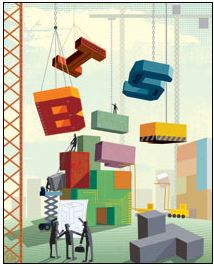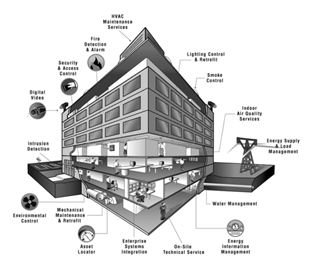February 2011
Article
AutomatedBuildings.com |
[an error occurred while processing this directive]
(Click Message to Learn More) |
Designing An Integrated Building System
The heart of the IBS is in the integration of building systems in a way that
provides greater functionality and facilitates optimum building operations.
|
|
“Design is not just what it looks like and feels like. Design is how it works.”
Steve Jobs, Apple
Overview
About every seven years the format for construction specifications -
the MasterFormat produced and trademarked by the Construction
Specifications Institute - is updated. This process reflects new design
and construction requirements. The format for specifications is
critical as it standardizes and organizes the construction documents;
the results of which are ease of use, reduction of errors and
facilitation of design coordination.
 During the previous revision of the MasterFormat in 2004 Division 25
covering Integrated Automation was added. The addition of an Integrated
Automation Division recognized a broader inclusion of technology in the
2004 revision, an area woefully ignored in the earlier construction
specifications. Moreover, Division 25 was an unheralded milestone as it
gave credibility and visibility to building systems and their
integration, quietly reinforcing their implicit value for buildings.
During the previous revision of the MasterFormat in 2004 Division 25
covering Integrated Automation was added. The addition of an Integrated
Automation Division recognized a broader inclusion of technology in the
2004 revision, an area woefully ignored in the earlier construction
specifications. Moreover, Division 25 was an unheralded milestone as it
gave credibility and visibility to building systems and their
integration, quietly reinforcing their implicit value for buildings.
Industry reaction to the use of Division 25 has generally been subdued;
it was a totally new division unlike many of the older spec divisions
that were just renumbered and revised. It did not have the “heft” of
specifications for structural, mechanical and other divisions; there
was also some confusion as to which divisions were to carry parts of
building systems, and finally, a general lack of understanding or
appreciation of integrated systems by the AEC industry. This doesn’t
mean that it hasn’t been used but that it has been underutilized and
typically addressed much later in the design process. One would have
thought that industry recognition of integrated systems seven years ago
would have pretty much quelled any doubters of its value; Division 25
would surely be mainstream and integrated systems part of the
programming and conceptual design for any new facility.
What is Division 25?
 Division 25 is within the specification group of the MasterFormat and
part of the Facility Services subgroup which includes fire suppression,
plumbing, heating/ventilating/air conditioning, electrical,
communications and electronic safety and security. Integrated
automation is clustered with all the other sections in which individual
building systems may be specified. Division 25 focuses on the
interaction between building systems and the optimization of building
operations. While almost every aspect of the decision-making process
made during design and construction may have some impact on operations
and maintenance, integrated building systems are directed towards
operations. While BMS systems have some limited capabilities to
integrate systems - typically through physical connections - they are
not necessarily capable of integrating all building systems and doing
it in a way where every point can be read or written to and from one
system. This gives rise to something beyond the BMS and the need for an
Integrated Building System (IBS). Although Division 25 is
designated as Integrated Automation it really embodies an Integrated
Building System.
Division 25 is within the specification group of the MasterFormat and
part of the Facility Services subgroup which includes fire suppression,
plumbing, heating/ventilating/air conditioning, electrical,
communications and electronic safety and security. Integrated
automation is clustered with all the other sections in which individual
building systems may be specified. Division 25 focuses on the
interaction between building systems and the optimization of building
operations. While almost every aspect of the decision-making process
made during design and construction may have some impact on operations
and maintenance, integrated building systems are directed towards
operations. While BMS systems have some limited capabilities to
integrate systems - typically through physical connections - they are
not necessarily capable of integrating all building systems and doing
it in a way where every point can be read or written to and from one
system. This gives rise to something beyond the BMS and the need for an
Integrated Building System (IBS). Although Division 25 is
designated as Integrated Automation it really embodies an Integrated
Building System.
Division 25 has the usual specification format: a GENERAL component
laying out the administrative and procedural requirements for the
contractor on the job, a PRODUCTS part listing for the equipment,
materials and products required, and an EXECUTION scheme describing how
the products and equipment are to be installed, post installation
requirements, documentation, etc. The subsections of Division 25
provide a listing of what must be specified for an IBS:
• Operation and Maintenance
• Conductors and Cables
• Schedules
• Commissioning
• Network Equipment
• Network Devices
• Network Gateways
• Control and Monitoring Network
• Local Control Units
• Software
• Instrumentation and Terminal Devices
• Control
• Control Sequences
While the number or types of building systems are not restricted in the
specification format, the systems specifically mentioned include:
• Facility Equipment
• Conveying Equipment
• Fire-Suppression Systems
• Plumbing
• HVAC
• Electrical Systems
• Communications Systems
• Electronic Safety and Security Systems
Within each of these systems there are additional levels of detail that
the IBS must address. For example with HVAC there are specific sections
for terminal devices such as actuators and operators, sensors and
transmitters, control valves, control dampers and compressed air
supply. For electrical systems there’s a specific section on terminal
devices such as power meters, KW transducers, current sensors, battery
monitors, lighting relays and UPS monitors.
Preparing the Spec
 Developing a good Division 25 is much more than following a format;
it’s about articulating the client’s requirements and at the same time
clearly conveying to a potential installer or contractor what needs to
be developed, fabricated, installed or constructed as well as how it
needs to operate and supported. Some of the issues in preparing a
specification include:
Developing a good Division 25 is much more than following a format;
it’s about articulating the client’s requirements and at the same time
clearly conveying to a potential installer or contractor what needs to
be developed, fabricated, installed or constructed as well as how it
needs to operate and supported. Some of the issues in preparing a
specification include:
Extensive Coordination With Designers For The Systems – The premise is
that individual building systems are specified in other Divisions and
Division 25 is focused primarily on integration of those systems. In
order to facilitate integration the designer of Division 25 must
coordinate or guide and at times require other designers to conform to
some set of integration standards in order to address communication
protocols, databases, etc. You’ll want to provide an open architecture
and at the same time minimize the use of different protocols or
database standards. The Division 25 format does have a subsection on
network gateways but you’ll want to avoid or minimize their use as they
add another piece of hardware to the network and with it another
potential failure point. Surely you’ll need some middleware to
standardize and normalize the system data but you’ll want to keep the
process as lean and as simple as possible.
Software Applications – The starting point for developing
specifications for software applications is to first work with the
building owner to define how the building will operate and what
software tools will be necessary for its support. These will be tools
such as scheduling, trending, system analytics, energy management,
alarm management, etc.
Overload. There are too many processes running under this userid. Please wait a minute and try again. (fork failed)
In addition, there needs to be recognition that the IBS is an
enterprise system with read/write capabilities to every point and the
platform to monitor and manage all building systems. As an enterprise
system the IBS may be integrated with other enterprise systems such as
asset management or purchasing. While some subsystems integrated into
the IBS like lighting or a DDC system may still have administrative
workstations or databases, the capabilities of these systems may be
relegated to configuration tools for specific controllers, field
devices or control loops.
Sequence of Operations – The heart of the IBS is in the integration of
building systems in a way that provides greater functionality and
facilitates optimum building operations. This should begin with a
matrix of the systems and discussions or coordination with the owner
and the design team to examine the interactions between building
systems - the details or the “nuts and bolts” of how the integration
happens has to be embodied in the sequence of operations for each
interaction between systems.
Given the transformation and changes in building design, construction
and operation since the last revision of the MasterFormat, we can
expect many changes will be warranted in the next revision, including
the growing importance of technology and building systems. For more
information, write us at info@smart-buildings.com
MAJOR SECTIONS OF DIVISION 25 – INTEGRATED AUTOMATION
25 01 00 Operation and Maintenance of IA
25 05 13 Conductors and Cables for IA
25 06 00 Schedules for IA
25 08 00 Commissioning of IA
25 10 00 IA Network Equipment
25 11 00 IA Network Devices
25 12 00 IA Network Gateways
25 13 00 IA Control and Monitoring Network
25 14 00 IA Local Control Units
25 15 00 IA Software
25 30 00 IA Instrumentation and Terminal Devices
25 31 00 IA Instrumentation and Terminal Devices for Facility Equipment
25 32 00 IA Instrumentation and Terminal Devices for Conveying Equipment
25 33 00 IA Instrumentation and Terminal Devices for Fire-Suppression Systems
25 34 00 IA Instrumentation and Terminal Devices for Plumbing
25 35 00 IA Instrumentation and Terminal Devices for HVAC
25 36 00 IA Instrumentation and Terminal Devices for Electrical Systems
25 37 00 IA Instrumentation and Terminal Devices for Communications Systems
25 38 00 IA Instrumentation and Terminal Devices for Electronic Safety and Security System
25 50 00 IA Facility Controls
25 51 00 IA Control of Facility Equipment
25 52 00 IA Control of Conveying Equipment
25 53 00 IA Control of Fire-Suppression Systems
25 54 00 IA Control of Plumbing
25 55 00 IA Control of HVAC
25 56 00 IA Control of Electrical Systems
25 57 00 IA Control of Communications Systems
25 58 00 IA Control of Electronic Safety and Security Systems
25 90 00 IA Control Sequences
25 91 00 IA Control Sequences for Facility Equipment
25 92 00 IA Control Sequences for Conveying Equipment
25 93 00 IA Control Sequences for Fire Suppression Systems
25 94 00 IA Control Sequences for Plumbing
25 95 00 IA Control Sequences for HVAC
25 96 00 IA Control Sequences for Electrical Systems
25 97 00 IA Control Sequences for Communications Systems
25 98 00 IA Control Sequences for Electronic Safety and Security Systems
footer
Overload. There are too many processes running under this userid. Please wait a minute and try again. (fork failed)
[Click Banner To Learn More]
[Home Page] [The
Automator] [About] [Subscribe
] [Contact
Us]